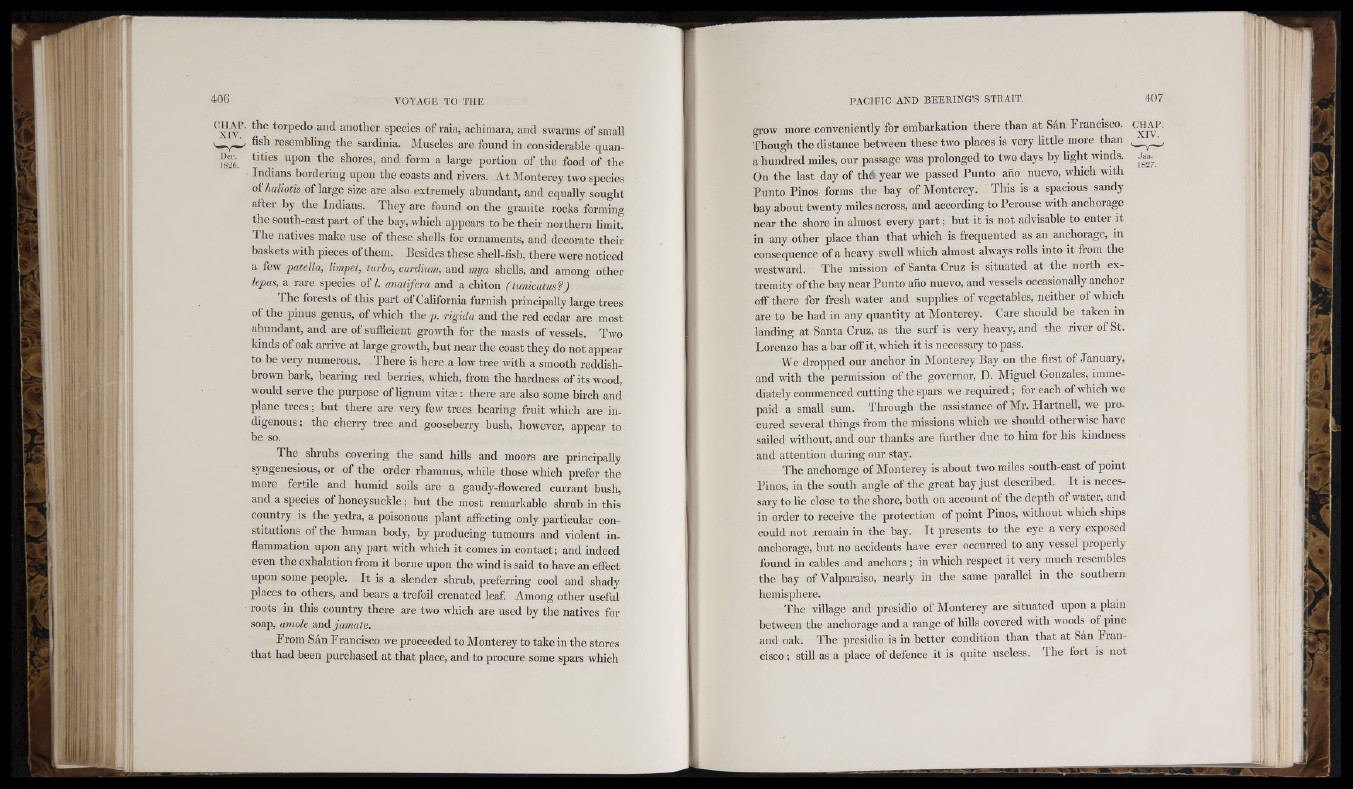
li';: :
C H A P . the torpedo and another species of raia, achimara, and swarms of small
fish resembling the Sardinia. Muscles are found in considerable quan-
isfe. s')®"®*. io"ni a large portion of the food of the
Indians bordering upon the coasts and rivers. At Monterey two species
o i haliotis of large size are also e.xtremely abundant, and equally sought
after by the Indians. They are found on the granite rocks forming
the south-east part of the bay, which appears to be their northern limit.
The natives make use of these shells for ornaments, and decorate their
baskets with pieces of them. Besides these shell-fish, there were noticed
a few patella, limpet, turbo, cardium, and mya shells, and among other
kpas, a rare species of I. anatifera and a chiton (tunicatus?)
The forests of this part of California furnish principally large trees
of the pinus genus, of which the p. rigida and the red cedar are most
abundant, and are of sufficient growth for the masts of vessels. Two
kinds of oak arrive at large growth, but near the coast they do not appear
to be very numerous. There is here a low tree with a smooth reddish-
brown bark, bearing red berries, which, from the hardness of its wood,
would serve the purpose of lignum vitm; there are also some birch and
plane trees; but there are very few trees bearing fruit which are indigenous;
the cherry tree and gooseberry bush, however, appear to
be so.
The shrubs covering the sand hills and moors are principally
syngenesious, or of the order rhamnus, while those which prefer the
more fertile and humid soils are a gaudy-flowered currant bush,
and a species of honeysuckle; but the most remarkable shrub in this
country is the yedra, a poisonous plant affecting only particular constitutions
of the human body, by producing tumours and violent inflammation
upon any part with which it comes in contact; and indeed
even the exhalation from it borne upon the wind is said to have an effect
upon some people. It is a slender shrub, preferring cool and shady
places to others, and bears a trefoil crenated leaf. Among other useful
roots in this country there are two which are used by the natives for
soap, amole andjamate.
From Sán Francisco we proceeded to Monterey to take in the stores
that had been purchased at that place, and to procure some spars which
grow more conveniently for embarkation there than at Sán Francisco. CHAP.
Though the distance between these two places is very little more than ,— ^
a hundred miles, our passage was prolonged to two days by light winds.
On the last day of thé year we passed Punto año nuevo, which with
Punto Pinos forms the bay of Monterey. This is a spacious sandy
bay about twenty miles across, and according to Perouse with anchorage
near the shore in almost every part; but it is not advisable to enter it
in any other place than that which is frequented as an anchorage, in
consequence of a heavy swell which almost always rolls into it from the
westward. The mission of Santa Cruz is situated at the north extremity
of the bay near Punto año nuevo, and vessels occasionally anchor
off there for fresh water and supplies of vegetables, neither of which
are to be had in any quantity at Monterey. Care should be taken in
landing at Santa Cruz, as the surf is very heavy, and the river of St.
Lorenzo has a bar off it, which it is necessary to pass.
We dropped our anchor in Monterey Bay on the first of January,
and with the permission of the governor, D. Miguel Gonzales, immediately
commenced cutting the spars we required ; for each of which we
paid a small sum. Through the assistance of Mr. Hartnell, we procured
several things from the missions which we should otherwise have
sailed without, and our thanks are further due to him for his kindness
and attention during our stay.
The anchorage of Monterey is about two miles south-east of point
Pinos, ill the south angle of the great bay just described. It is necessary
to lie close to the shore, both on account of the depth of water, and
in order to receive the protection of point Pinos, without which ships
could not remain in the bay. It presents to the eye a very exposed
anchorage, but no accidents have ever occurred to any vessel properly
found in cables and anchors ; in wliich respect it very much resembles
the bay of Valparaiso, nearly in the same parallel in the southern
hemisphere.
The village and presidio of Monterey are situated upon a plain
between the anchorage and a range of hills covered with woods of pine
and oak. The presidio is in better condition than that at San Francisco
; still as a place of defence it is quite useless. The fort is not